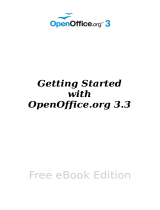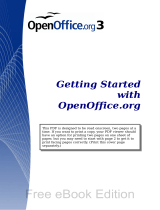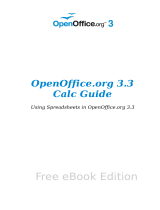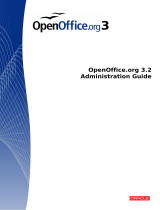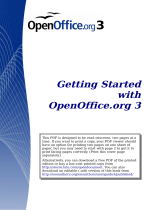Page is loading ...

OpenOffice.org 3.3
Writer Guide
Word Processing with OpenOffice.org 3.3

Copyright
This document is Copyright © 2005–2010 by its contributors as listed below. You may
distribute it and/or modify it under the terms of either the GNU General Public
License (http://www.gnu.org/licenses/gpl.html), version 3 or later, or the Creative
Commons Attribution License (http://creativecommons.org/licenses/by/3.0/), version
3.0 or later.
Contributors
Jean Hollis Weber Michele Zarri Gary Schnabl
Magnus Adielsson Agnes Belzunce Ken Byars
Bruce Byfield Daniel Carrera Dick Detwiler
Alexander Noël Dunne Laurent Duperval Martin Fox
Katharina Greif Tara Hess Peter Hillier-Brook
Lou Iorio John Kane Rachel Kartch
Stefan A. Keel Jared Kobos Michael Kotsarinis
Sigrid Kronenberger Peter Kupfer Ian Laurenson
Alan Madden Paul Miller Vincenzo Ponzi
Scott Rhoades Carol Roberts Iain Roberts
Joe Sellman Robert Scott Janet M. Swisher
Barbara M. Tobias Catherine Waterman Sharon Whiston
Bob Wickham Claire Wood Linda Worthington
Feedback
Please direct any comments or suggestions about this document to:
Publication date and software version
Published 27 December 2010. Based on OpenOffice.org 3.3.
Note for Mac users
Some keystrokes and menu items are different on a Mac from those used in Windows
and Linux. The table below gives some common substitutions for the instructions in
this chapter. For a more detailed list, see the application Help.
Windows/Linux Mac equivalent Effect
Tools > Options
menu selection
OpenOffice.org >
Preferences
Access setup options
Right-click Control+click Open context menu
Ctrl (Control) z (Command) Used with other keys
F5 Shift+z+F5 Open the Navigator
F11 z+T Open Styles & Formatting window
You can download
an editable version of this document from
http://oooauthors.org/english/userguide3/published/

Contents
Copyright................................................................................................................... 2
Note for Mac users.................................................................................................... 2
Chapter 1
Introducing Writer....................................................................................................... 9
What is Writer?........................................................................................................ 10
Parts of the main Writer window.............................................................................10
Changing document views.......................................................................................17
Starting a new document.........................................................................................17
Opening an existing document................................................................................19
Saving a document...................................................................................................20
Password protection................................................................................................. 22
Closing a document..................................................................................................23
Closing OpenOffice.org............................................................................................23
Using the Navigator.................................................................................................24
Getting help............................................................................................................. 28
What are all these things called?.............................................................................28
Undoing and redoing changes.................................................................................29
Using Writer on a Mac.............................................................................................30
Chapter 2
Setting up Writer....................................................................................................... 31
Choosing options that affect all of OOo...................................................................32
Choosing options for loading and saving documents...............................................43
Choosing options for Writer.....................................................................................48
Choosing options for HTML documents..................................................................57
Choosing language settings.....................................................................................58
Controlling Writer’s AutoCorrect functions.............................................................60
Chapter 3
Working with Text...................................................................................................... 62
Introduction............................................................................................................. 63
Selecting text........................................................................................................... 63
Cutting, copying, and pasting text...........................................................................64
Finding and replacing text.......................................................................................65
Inserting special characters....................................................................................68
Formatting paragraphs............................................................................................ 70
Formatting characters.............................................................................................73
Autoformatting......................................................................................................... 74
Creating numbered or bulleted lists........................................................................75
Using footnotes and endnotes..................................................................................78
Checking spelling and grammar..............................................................................80
Using built-in language tools................................................................................... 82
Using synonyms and the thesaurus.........................................................................84
Hyphenating words.................................................................................................. 85
OpenOffice.org 3.3 Writer Guide 3

Using AutoCorrect................................................................................................... 87
Using word completion............................................................................................88
Using AutoText......................................................................................................... 89
Line numbering........................................................................................................ 91
Tracking changes to a document.............................................................................92
Adding other comments...........................................................................................96
Linking to another part of a document....................................................................97
Switching between insert and overwrite mode.....................................................100
Counting the words in a selection.........................................................................100
Changing the case of selected text........................................................................101
Chapter 4
Formatting Pages.....................................................................................................102
Introduction........................................................................................................... 103
Choosing a layout method......................................................................................103
Setting up basic page layout using styles..............................................................105
Changing page margins.........................................................................................109
Using columns to define the page layout...............................................................110
Using frames for page layout.................................................................................114
Using tables for page layout..................................................................................119
Using sections for page layout...............................................................................122
Updating links........................................................................................................ 129
Creating headers and footers................................................................................130
Numbering pages...................................................................................................135
Defining borders and backgrounds........................................................................144
Chapter 5
Printing, Exporting, Faxing, and E-Mailing.............................................................148
Introduction........................................................................................................... 149
Quick printing........................................................................................................149
Controlling printing............................................................................................... 149
Printing envelopes................................................................................................. 156
Printing labels........................................................................................................ 158
Sending a fax......................................................................................................... 160
Exporting to PDF...................................................................................................160
Exporting to XHTML..............................................................................................166
E-mailing Writer documents..................................................................................166
Digital signing of documents.................................................................................169
Removing personal data........................................................................................170
Chapter 6
Introduction to Styles..............................................................................................171
What are styles?..................................................................................................... 172
The Styles and Formatting window.......................................................................173
Applying styles....................................................................................................... 177
Modifying styles..................................................................................................... 183
Creating custom paragraph styles: examples........................................................187
4 OpenOffice.org 3.3 Writer Guide

Copying and moving styles....................................................................................191
Deleting styles....................................................................................................... 192
Assigning styles to shortcut keys...........................................................................193
Defining a hierarchy of headings...........................................................................193
Chapter 7
Working with Styles................................................................................................. 201
Introduction........................................................................................................... 202
Creating custom (new) styles.................................................................................202
Working with paragraph styles..............................................................................205
Working with conditional paragraph styles...........................................................215
Working with character styles...............................................................................217
Working with frame styles..................................................................................... 219
Working with page styles.......................................................................................221
Working with list styles..........................................................................................228
Chapter 8
Working with Graphics.............................................................................................236
Graphics (images) in Writer...................................................................................237
Creating and editing images..................................................................................237
Adding images to a document................................................................................238
Modifying an image...............................................................................................242
Using Writer’s drawing tools.................................................................................248
Positioning graphics within the text......................................................................251
Adding captions to graphics..................................................................................259
Creating an image map..........................................................................................262
Adding an image to the Gallery.............................................................................263
Chapter 9
Working with Tables................................................................................................. 265
Introduction........................................................................................................... 266
Creating a table..................................................................................................... 266
Formatting the table layout...................................................................................269
Formatting the table text.......................................................................................277
Data entry and manipulation in tables...................................................................280
Additional table operations....................................................................................282
The Table menu and toolbar..................................................................................287
Chapter 10
Working with Templates........................................................................................... 290
Introduction........................................................................................................... 291
Using a template to create a document.................................................................291
Creating a template...............................................................................................292
Editing a template.................................................................................................. 294
Adding templates with Extension Manager...........................................................296
Setting a default template.....................................................................................297
Associating a document with a different template................................................298
Organizing templates............................................................................................. 299
OpenOffice.org 3.3 Writer Guide 5

Chapter 11
Using Mail Merge.................................................................................................... 301
What is mail merge?..............................................................................................302
Creating the data source....................................................................................... 302
Registering a data source......................................................................................303
Creating a form letter............................................................................................305
Printing mailing labels........................................................................................... 310
Printing envelopes................................................................................................. 314
Using the Mail Merge Wizard to create a form letter...........................................318
Chapter 12
Tables of Contents, Indexes, and Bibliographies.....................................................330
Introduction........................................................................................................... 331
Tables of contents..................................................................................................331
Alphabetic indexes................................................................................................. 341
Other types of indexes...........................................................................................349
Bibliographies........................................................................................................ 351
Tools for working with bibliographies...................................................................361
Chapter 13
Working with Master Documents.............................................................................362
Why use a master document?................................................................................363
Styles in master documents and subdocuments....................................................363
Creating a master document: scenarios................................................................364
Splitting a document into master and subdocuments...........................................364
Combining several documents into a master document........................................365
Starting with no existing documents.....................................................................366
Restarting page numbering...................................................................................371
Editing a master document....................................................................................373
Cross-referencing between subdocuments............................................................374
Using the Navigator...............................................................................................378
Creating one file from a master document and its subdocuments........................379
Problem solving..................................................................................................... 381
Chapter 14
Working with Fields................................................................................................ 383
Introduction to fields............................................................................................. 384
Quick and easy field entry.....................................................................................384
Using document properties to hold metadata and information that changes.......384
Using other fields to hold information that changes.............................................386
Using AutoText to insert often-used fields.............................................................388
Defining your own numbering sequences..............................................................388
Using automatic cross-references.........................................................................390
Using fields in headers and footers.......................................................................394
Using fields instead of outline numbering for appendix numbering.....................396
Tricks for working with fields................................................................................397
Developing conditional content.............................................................................397
Using placeholder fields........................................................................................ 404
6 OpenOffice.org 3.3 Writer Guide

Using input fields and input lists...........................................................................405
Chapter 15
Using Forms in Writer.............................................................................................. 409
Introduction to forms............................................................................................. 410
When to use forms.................................................................................................410
Creating a simple form..........................................................................................411
Form controls reference........................................................................................413
Example: a simple form.........................................................................................418
Accessing data sources..........................................................................................423
Advanced form customization................................................................................429
XForms................................................................................................................... 432
Chapter 16
Customizing Writer.................................................................................................. 433
Introduction........................................................................................................... 434
Customizing menu content.................................................................................... 434
Customizing toolbars............................................................................................. 437
Assigning shortcut keys.........................................................................................441
Assigning macros to events...................................................................................446
Adding functionality with extensions.....................................................................446
Appendix A
Keyboard Shortcuts..................................................................................................449
Introduction........................................................................................................... 450
Opening menus and menu items............................................................................450
Controlling dialogs.................................................................................................451
Stopping macros.................................................................................................... 451
Function keys for Writer........................................................................................ 452
Shortcut keys for Writer........................................................................................ 453
Shortcut keys for tables in Writer..........................................................................455
Shortcut keys for paragraphs and heading levels.................................................456
Shortcut keys for moving and resizing frames, graphics and objects...................457
Index.......................................................................................................................... 458
OpenOffice.org 3.3 Writer Guide 7

8 OpenOffice.org 3.3 Writer Guide

Chapter 1
Introducing Writer
9

What is Writer?
Writer is the word processor component of OpenOffice.org (OOo). It provides the
usual features of a word processor: enter and edit text, spelling check, thesaurus,
hyphenation, autocorrect, find and replace, automatic generation of tables of
contents and indexes, mail merge, and others.
In addition, Writer provides these important features:
• Templates and styles
• Page-layout methods, including frames, columns, and tables
• Embedding or linking of graphics, spreadsheets, and other objects
• Built-in drawing tools
• Master documents—to group a collection of documents into a single document
• Change tracking during revisions
• Database integration, including a bibliography database
• Export to PDF, including bookmarks
• And many more
Styles are central to using Writer. Using styles, you can easily format your document
consistently and change the format with minimal effort. A style is a named set of
formatting options. Writer defines several types of styles, for different types of
elements: characters, paragraphs, pages, frames, and lists. Often, you are using
styles whether you realize it or not. The use of styles is described in more detail in
Chapter 6 (Introduction to Styles) and Chapter 7 (Working with Styles).
The other features of Writer listed above are covered in other chapters of this guide.
Parts of the main Writer window
The main Writer workspace is shown in Figure 1. Its features are described in this
section.
Title bar
The Title bar is located at the top of the Writer window, shows the file name of the
current document. When the document is newly created, the document name will
appear as Untitled X, where X is a number.
Menus
The Menu bar is located just below the Title bar. When you choose one of the menus
listed below, a submenu drops down to show commands.
• File contains commands that apply to the entire document such as Open,
Save, Print, and Export as PDF.
• Edit contains commands for editing the document such as Undo: xxx (where
xxx is the command to undo) and Find & Replace. It also contains
commands to cut, copy, and paste selected parts of your document.
• View contains commands for controlling the display of the document such as
Zoom and Web Layout.
10 OpenOffice.org 3.3 Writer Guide

Figure 1: The main Writer workspace in Print Layout view
• Insert contains commands for inserting elements into your document such as
headers, footers, and pictures.
• Format contains commands, such as Styles and Formatting, Paragraph,
and Bullets and Numbering, for formatting the layout of your document
• Table shows all commands to insert and edit a table in a text document.
• Tools contains functions such as Spelling and Grammar, Customize, and
Options.
• Window contains commands for the display window.
• Help contains links to the OpenOffice.org Help file, What’s This?, and
information about the program. See “Getting help” on page 28.
Toolbars
Writer has several types of toolbars: docked (fixed in place), floating, and tear-off.
Docked toolbars can be moved to different locations or made to float, and floating
toolbars can be docked.
The top toolbar, just under the Menu bar, is called the Standard toolbar. It is
consistent across the OpenOffice.org applications (Writer, Calc, Draw, Impress).
The second toolbar at the top is the Formatting bar. It is a context-sensitive; that is, it
shows the tools relevant to the cursor’s current position or selection. For example,
when the cursor is on a graphic, the Formatting bar provides tools for formatting
graphics; when the cursor is in text, the tools are for formatting text.
Displaying or hiding toolbars
To display or hide toolbars, choose View > Toolbars, then click on the name of a
toolbar in the list. An active toolbar shows a check mark beside its name. Tear-off
toolbars are not listed in the View menu.
Chapter 1 Introducing Writer 11

Submenus and tear-off toolbars
Toolbar icons with a small triangle to the right will display submenus, tear-off
toolbars, and other ways of selecting things, depending on the icon.
An example of a tear-off toolbar is shown in Figure 2. Tear-off toolbars can be floating
or docked along an edge of the screen or in one of the existing toolbar areas. To move
a floating tear-off toolbar, drag it by the title bar, as shown in Figure 4.
Figure 2: Example of a tear-off toolbar
Moving toolbars
To move a docked toolbar, place the mouse pointer over the toolbar handle, hold
down the left mouse button, drag the toolbar to the new location, and then release
the mouse button.
Figure 3: Moving a docked toolbar
To move a floating toolbar, click on its title bar and drag it to a new location.
Figure 4: Moving a floating toolbar
12 OpenOffice.org 3.3 Writer Guide

Floating toolbars
Writer includes several additional context-sensitive toolbars, whose defaults appear
as floating toolbars in response to the cursor’s current position or selection. For
example, when the cursor is in a table, a floating Table toolbar appears, and when the
cursor is in a numbered or bullet list, the Bullets and Numbering toolbar appears.
You can dock these toolbars to the top, bottom, or side of the window, if you wish (see
“Moving toolbars” on page 12).
Docking/floating windows and toolbars
Toolbars and some windows, such as the Navigator and the Styles and Formatting
window, are dockable. You can move, resize, or dock them to an edge.
To dock a window or toolbar, hold down the Control key and double-click on the
frame of the floating window (or in a vacant area near the icons at the top of the
floating window) to dock it in its last position.
Figure 5: Control+click to dock or undock
To undock a window, hold down the Control key and double-click on the frame (or a
vacant area near the icons at the top) of the docked window.
Customizing toolbars
You can customize toolbars in several ways, including choosing which icons are
visible and locking the position of a docked toolbar.
To access a toolbar’s customization options, use the down-arrow at the end of the
toolbar or on its title bar (Figure 6).
Figure 6: Customizing toolbars
To show or hide icons defined for the selected toolbar, choose Visible Buttons from
the drop-down menu. Visible icons are indicated by a border around the icon (Figure
7). Click on icons to hide or show them on the toolbar.
You can also add icons and create new toolbars, as described in Chapter 16.
Chapter 1 Introducing Writer 13

Figure 7: Selection of visible toolbar icons
Right-click (context) menus
Right-click on a paragraph, graphic, or other object to open a context menu. Often
the context menu is the fastest and easiest way to reach a function. If you’re not sure
where in the menus or toolbars a function is located, you can often find it by right-
clicking.
Rulers
To show or hide rulers, choose View > Ruler. To enable the vertical ruler, choose
Tools > Options > OpenOffice.org Writer > View and select Vertical ruler.
Figure 8. Turning on the vertical ruler
Status bar
The Writer status bar is located at the bottom of the workspace. It provides
information about the document and convenient ways to quickly change some
document features.
Figure 9: Left end of status bar
14 OpenOffice.org 3.3 Writer Guide

Figure 10: Right end of status bar
Page number
Shows the current page number, the sequence number of the current page (if
different from the page number), and the total number of pages in the document.
For example, if a document has 14 pages and you restarted page numbering at 1
on the third page, its page number is 1, its sequence number is 3, and the total
number of pages is 14; this field would show 1 3/14.
If any bookmarks have been defined in the document, a right-click on this field
pops up a list of bookmarks; click on the required one to go to the bookmark.
To jump to a specific page in the document, double-click on this field. The
Navigator opens (see page 24). Click in the Page Number field in the Navigator
and type the sequence number of the required page. After a brief delay, the
display jumps to the selected page.
Page style
Shows the style of the current page. To change the page style, right-click on this
field. A list of page styles pops up; choose a different style by clicking on it.
To edit the current page style, double-click on this field. The Page Style dialog box
opens. See Chapter 6 and 7 in this book for more information about styles.
Language
Shows the language for the selected text.
Click to open a menu where you can choose another language for the selected text
or for the paragraph where the cursor is located. You can also choose None (Do
not check spelling) to exclude the text from a spelling check or choose More to
open the Character dialog box. See Chapter 3 (Working with Text) for more
information.
Insert mode
Click to toggle between Insert and Overwrite modes when typing. In Insert mode,
any text after the cursor position moves forward to make room for the text you
type; in Overwrite mode, text after the cursor position is replaced by the text you
type.
Selection mode
Click to toggle between STD (Standard), EXT (Extend), ADD (Add) and BLK
(Block) selection. EXT is an alternative to Shift+click when selecting text. See
Chapter 3 (Working with Text) for more information about these modes.
Unsaved changes
An asterisk (*) appears here if changes to the document have not been saved.
Digital signature
If the document has been digitally signed, an icon shows here. To view the
certificate, double-click the icon.
Chapter 1 Introducing Writer 15

Section or object information
When the cursor is in a section, heading, or list item, or when an object (such as a
picture or table) is selected, information about that item appears in this field.
Double-clicking in this area opens a relevant dialog box.
Object Information shown Dialog box opened
Picture Size and position Format Picture
List item Level and list style Bullets and Numbering
1
Heading Outline numbering level Bullets and Numbering
1
Table Name or number and cell
reference of cursor
Table Format
Section Name of section Edit Sections
Other (Blank) Fields (Cross References page)
View layout
Click an icon to change between single page, side-by-side, and book layout views.
You can edit the document in any view. Zoom settings (see below and next page)
interact with the selected view layout to determine how many pages are visible in
the document window.
Figure 11. View layouts: single, side-by-side, book
Zoom
To change the view magnification, drag the Zoom slider, or click on the + and –
signs, or right-click on the zoom level percent to pop up a list of magnification
values from which to choose.
1 If a list style was used with a list item or heading, no dialog box appears.
16 OpenOffice.org 3.3 Writer Guide

Changing document views
Writer has three ways to view a document: Print Layout, Web Layout, and Full
Screen. To change the view, go to the View menu and click on the required view.
Print Layout is the default view in Writer. In this view, you can use the Zoom slider
and the View Layout icons on the Status bar to change the magnification.
You can also choose View > Zoom from the menu bar to display the Zoom & View
Layout dialog box (see Figure 12), where you can set the same options as on the
Status bar.
Figure 12. Choosing Zoom and View Layout options
In Web Layout view, you can use the Zoom slider; the View Layout buttons on the
Status bar are disabled, and most of the choices on the Zoom & View Layout dialog
box are not available.
In Full Screen view, the document is displayed using the zoom and layout settings
previously selected. To exit Full Screen view and return to either Print or Web Layout
view, press the Esc key or click the Full Screen icon in the top left-hand corner. You
can also use Ctrl+Shift+J to enter or exit Full Screen view.
Starting a new document
You can start a new, blank document in Writer in several ways.
• From the operating system menu, in the same way that you start other
programs. When OOo was installed on your computer, in most cases a menu
entry for each component was added to your system menu. If you are using a
Mac, you should see the OpenOffice.org icon in the Applications folder. When
you double-click this icon, OOo opens at the Start Center (Figure 14).
• From the Quickstarter, which is found in Windows, some Linux distributions,
and (in a slightly different form) in Mac OS X. The Quickstarter is an icon that
is placed in the system tray or the dock during system startup. It indicates that
OpenOffice.org has been loaded and is ready to use.
Right-click the Quickstarter icon (Figure 13) in the system tray to open a pop-
up menu from which you can open a new document, open the Templates and
Documents dialog box, or choose an existing document to open. You can also
double-click the Quickstarter icon to display the Templates and Documents
dialog box.
Chapter 1 Introducing Writer 17

See Chapter 1 (Introducing OpenOffice.org) in the Getting Started guide for
more information about starting Writer and using the Quickstarter.
Figure 13: Quickstarter pop-up menu on Windows XP
• From the Start Center. When OOo is open but no document is open (for
example, if you close all the open documents but leave the program running),
the Start Center is shown. Click one of the icons to open a new document of
that type, or click the Templates icon to start a new document using a
template. If a document is already open in OOo, the new document opens in a
new window.
Figure 14: OpenOffice.org Start Center
When OOo is open, you can also start a new document in one of the following ways.
• Press the Control+N keys.
• Use File > New > Text Document.
• Click the New button on the main toolbar.
18 OpenOffice.org 3.3 Writer Guide

Starting a new document from a template
You can use templates to create new documents in Writer. A template is a set of
predefined styles and formatting. Templates serve as the foundation of a set of
documents, to make sure they all have a similar layout. For example, all the
documents of the Writer Guide are based on the same template. As a result, all the
documents look alike; they have the same headers and footers, use the same fonts,
and so on.
A new OpenOffice.org installation does not contain many templates. It is possible for
you to add new templates to your installation and use them for new documents. This
is explained in Chapter 10 (Working with Templates). Many more templates can be
downloaded from http://extensions.services.openoffice.org/ and other websites.
Once you have templates on your system, you can create new documents based on
them by using File > New > Templates and Documents. This opens a window
where you can choose the template you want to use for your document.
The example shown in Figure 15 uses a template called “OOo3_3_chapter_template”
in the My Templates folder. Select it, then click the Open button. A new document is
created based on the styles and formats defined in the template.
Figure 15. Creating a document from a template
Opening an existing document
When no document is open, the Start Center (Figure 14) provides an icon for opening
an existing document or choosing from a list of recently-edited documents.
Chapter 1 Introducing Writer 19

You can also open an existing document in one of the following ways. If a document is
already open in OOo, the second document opens in a new window.
• Choose File > Open....
• Click the Open button on the main toolbar.
• Press Control+O on the keyboard.
• Use the Open Document or Recent Documents selections on the
Quickstarter.
In each case, the Open dialog box appears. Select the file you want, and then click
Open. If a document is already open in OOo, the second document opens in a new
window.
In the Open dialog box, you can reduce the list of files by selecting the type of file you
are looking for. For example, if you choose Text documents as the file type, you will
only see documents Writer can open (including *.odt, *.doc, *.txt). This method opens
Word (*.doc) files as well as OOo files and other formats.
You can also open an existing Writer document using the same methods you would
use to open any document in your operating system.
If you have associated Microsoft Office file formats with OpenOffice.org, you can also
open these files by double-clicking on them. Recent Documents
Saving a document
To save a new document in Writer, do one of the following:
• Press Control+S.
• Choose File > Save.
• Click the Save button on the main toolbar.
When the Save As dialog box appears, enter the file name, verify the file type (if
applicable), and click Save.
To save an open document with the current file name, choose File > Save. This will
overwrite the last saved state of the file.
Saving a document automatically
You can choose to have Writer save your document automatically at regular intervals.
Automatic saving, like manual saving, overwrites the last saved state of the file. To
set up automatic file saving:
1) Select Tools > Options > Load/Save > General.
2) Click on Save AutoRecovery information every and set the time interval.
The default value is 15 minutes. Enter the value you want by typing it or by
pressing the up or down arrow keys.
Saving as a Microsoft Word document
If you need to exchange files with users of Microsoft Word, they may not know how to
open and save .odt files. Microsoft Word 2007 with Service Pack 2 (SP2) can do this.
Users of Word 2007, 2003, XP, and 2000 can also download and install a free
OpenDocument Format (ODF) plugin from Sun Microsystems, available from
20 OpenOffice.org 3.3 Writer Guide
/
